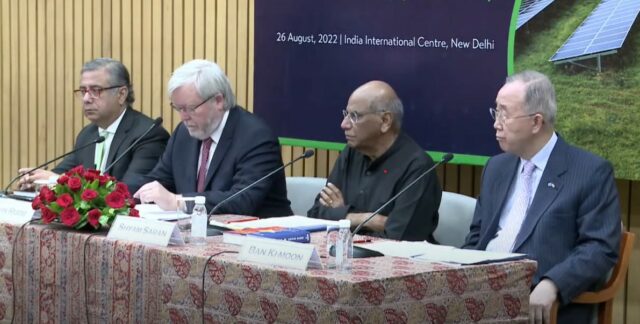NEW DELHI: Getting India to Net Zero is the title not of a Government of India policy document but a paper authored by the Asia Society Policy Institute, which was released at the India International Centre in Delhi on Friday.
As the title suggests, it is all about nudging India to do more heavy lifting on climate change, which includes rolling back the 2070 net zero deadline (set by Prime Minister Modi at COP26 in Glasgow last November) to 2050.
The report claims doing so “could maximize GDP growth … by as much as 7.3% in the 2030s.”
Among the recommendations it makes is phasing out “unabated coal power by 2040” and increasing the renewable capacity target well beyond the 500GW that India had set for itself. It calls for frontloading the most ambitious decarbonizing goals, saying it would create 20 million jobs.
The hitch here, former foreign secretary Shyam Saran notes, is that India’s per capita energy consumption is one third the global average (680 kgoe vs 1800 kgoe). A wholesale phase out of coal is unrealistic, he warns. “This would in reality mean that for several years during the current decade India must reconcile to no increase in its energy use and therefore virtually no GDP growth and little or no employment generation.”
Interesting to note, that with the energy crisis triggered by the Ukraine war, Germany and Japan (both strong advocates of climate change policies) have declared plans to return to coal. As Ambassador Saran notes, what Germany and Japan are doing is to maintain their current lifestyle. But India needs coal for survival. “They need to be treated differently. The principle of equity has to be an indispensable part of any climate conversation,” he says.
As for the speedy transition to renewables, there will be a massive shift of labour from fossil to non-fossil activities which implies retraining, reallocation on a scale that may not have been fully accounted for.
The report acknowledges that India would need more than $10 trillion of additional investment to reach the 2070 zero emissions target, or $13 trillion if the target was 2050. But where would this money come from?
It recommends a combination of policies while warning against relying on domestic resources to fund it. It says “leveraging international support would free up domestic finance for development, poverty reduction … helping mitigate the negative impact on households.”
The report goes on to say India must develop a “pipeline of bankable projects that can easily be picked up by international investors with the capital and appetite to invest in India’s net zero transition.”
This is vague, to say the least. Frankly, the developed world’s credibility on financing climate change is poor. They are yet to deliver on the 2009 promise of $100 billion every year in climate funding.
Ambassador Saran underscored that point: “It is not clear whether such funding is available from public sources, multilateral institutions or commercial sources. Actually, on past record it is the lack of credibility of commitments made for transfer of finance and technology from developed to developing countries which needs to be addressed.”
Saran believes that rather than emissions, the focus should be on reinforcing moves in India to adopt low carbon strategies, such as energy efficient buildings or designing cities that encourage the use of mass transport such as buses or bicycles. The point is India is still building infrastructure and there is an opportunity here for the developed world to partner with India in adopting a low carbon trajectory.
As far back as 2008, India’s National Action Plan on Climate Change recognised the need to gradually shift away from a development model driven by fossil fuels to one based on renewable energy and nuclear energy. That commitment was reaffirmed and strengthened recently with the government focus on hydrogen as the fuel for the future. India’s commitment to climate change cannot be questioned. The Asia Society report, while well meaning, is just that, a report. India will craft its own course.
Thirty eight years in journalism, widely travelled, history buff with a preference for Old Monk Rum. Current interest/focus spans China, Technology and Trade. Recent reads: Steven Colls Directorate S and Alexander Frater's Chasing the Monsoon. Netflix/Prime video junkie. Loves animal videos on Facebook. Reluctant tweeter.





